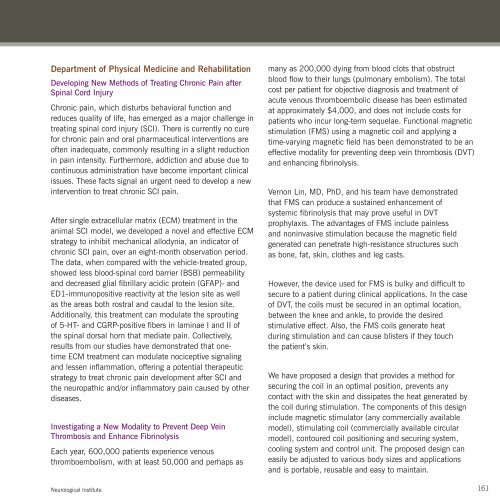2010 Neurological Institute Outcomes - Cleveland Clinic
2010 Neurological Institute Outcomes - Cleveland Clinic
2010 Neurological Institute Outcomes - Cleveland Clinic
Create successful ePaper yourself
Turn your PDF publications into a flip-book with our unique Google optimized e-Paper software.
Department of Physical Medicine and Rehabilitation<br />
Developing New Methods of Treating Chronic Pain after<br />
Spinal Cord Injury<br />
Chronic pain, which disturbs behavioral function and<br />
reduces quality of life, has emerged as a major challenge in<br />
treating spinal cord injury (SCI). There is currently no cure<br />
for chronic pain and oral pharmaceutical interventions are<br />
often inadequate, commonly resulting in a slight reduction<br />
in pain intensity. Furthermore, addiction and abuse due to<br />
continuous administration have become important clinical<br />
issues. These facts signal an urgent need to develop a new<br />
intervention to treat chronic SCI pain.<br />
After single extracellular matrix (ECM) treatment in the<br />
animal SCI model, we developed a novel and effective ECM<br />
strategy to inhibit mechanical allodynia, an indicator of<br />
chronic SCI pain, over an eight-month observation period.<br />
The data, when compared with the vehicle-treated group,<br />
showed less blood-spinal cord barrier (BSB) permeability<br />
and decreased glial fibrillary acidic protein (GFAP)- and<br />
ED1-immunopositive reactivity at the lesion site as well<br />
as the areas both rostral and caudal to the lesion site.<br />
Additionally, this treatment can modulate the sprouting<br />
of 5-HT- and CGRP-positive fibers in laminae I and II of<br />
the spinal dorsal horn that mediate pain. Collectively,<br />
results from our studies have demonstrated that onetime<br />
ECM treatment can modulate nociceptive signaling<br />
and lessen inflammation, offering a potential therapeutic<br />
strategy to treat chronic pain development after SCI and<br />
the neuropathic and/or inflammatory pain caused by other<br />
diseases.<br />
Investigating a New Modality to Prevent Deep Vein<br />
Thrombosis and Enhance Fibrinolysis<br />
Each year, 600,000 patients experience venous<br />
thromboembolism, with at least 50,000 and perhaps as<br />
<strong>Neurological</strong> <strong>Institute</strong><br />
many as 200,000 dying from blood clots that obstruct<br />
blood flow to their lungs (pulmonary embolism). The total<br />
cost per patient for objective diagnosis and treatment of<br />
acute venous thromboembolic disease has been estimated<br />
at approximately $4,000, and does not include costs for<br />
patients who incur long-term sequelae. Functional magnetic<br />
stimulation (FMS) using a magnetic coil and applying a<br />
time-varying magnetic field has been demonstrated to be an<br />
effective modality for preventing deep vein thrombosis (DVT)<br />
and enhancing fibrinolysis.<br />
Vernon Lin, MD, PhD, and his team have demonstrated<br />
that FMS can produce a sustained enhancement of<br />
systemic fibrinolysis that may prove useful in DVT<br />
prophylaxis. The advantages of FMS include painless<br />
and noninvasive stimulation because the magnetic field<br />
generated can penetrate high-resistance structures such<br />
as bone, fat, skin, clothes and leg casts.<br />
However, the device used for FMS is bulky and difficult to<br />
secure to a patient during clinical applications. In the case<br />
of DVT, the coils must be secured in an optimal location,<br />
between the knee and ankle, to provide the desired<br />
stimulative effect. Also, the FMS coils generate heat<br />
during stimulation and can cause blisters if they touch<br />
the patient’s skin.<br />
We have proposed a design that provides a method for<br />
securing the coil in an optimal position, prevents any<br />
contact with the skin and dissipates the heat generated by<br />
the coil during stimulation. The components of this design<br />
include magnetic stimulator (any commercially available<br />
model), stimulating coil (commercially available circular<br />
model), contoured coil positioning and securing system,<br />
cooling system and control unit. The proposed design can<br />
easily be adjusted to various body sizes and applications<br />
and is portable, reusable and easy to maintain.<br />
161
















